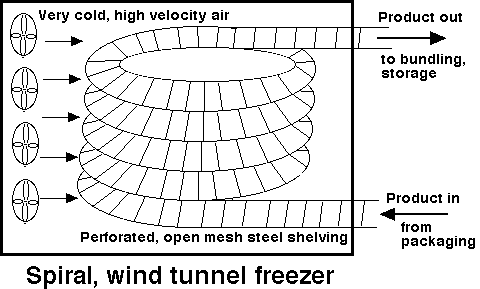Ice Cream Manufacture
8 Hardening
After the particulates have been added, the ice cream is packaged and is placed into a blast freezer at -30° to -40° C where most of the remainder of the water is frozen. Below about -25° C, ice cream is stable for indefinite periods without danger of ice crystal growth; however, above this temperature, ice crystal growth is possible and the rate of crystal growth is dependant upon the temperature of storage. This limits the shelf life of ice cream.
A primer on the theoretical aspects of freezing will help you to fully understand the freezing and recrystallization process.
Hardening invloves static (still, quiescent) freezing of the packaged products in blast freezers. Freezing rate must still be rapid, so freezing techniques involve low temperature (-40oC) with either enhanced convection (freezing tunnels with forced air fans) or enhanced conduction (plate freezers).

The rate of heat transfer in a freezing process is affected by the temperature difference, the surface area exposed and the heat transfer coefficient (Q=U A dT). Thus, the factors affecting hardening are those affecting this rate of heat transfer:
- Temperature of blast freezer – the colder the temperature, the faster the hardening, the smoother the product.
- Rapid circulation of air – increases convective heat transfer.
- Temperature of ice cream when placed in the hardening freezer – the colder the ice cream at draw, the faster the hardening; – must get through packaging operations fast.
- Size of container – exposure of maximum surface area to cold air, especially important to consider shrink wrapped bundles – they become a much larger mass to freeze. Bundling should be done after hardening.
- Composition of ice cream – related to freezing point depression and the temperature required to ensure a significantly high ice phase volume.
- Method of stacking containers or bundles to allow air circulation. Circulation should not be impeded – there should be no ‘dead air’ spaces (e.g., round vs. square packages).
- Care of evaporator – freedom from frost – acts as insulator.
- Package type, should not impede heat transfer – e.g., styrofoam liner or corrugated cardboard may protect against heat shock after hardening, but reduces heat transfer during freezing so not feasible.
Ice cream from the dynamic freezing process (continuous freezer) can also be transformed into an array of novely/impulse products through a variety of filling and forming machines, which have ben identified on a separate page.

